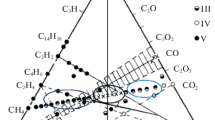Abstract
To account for the dominant formation of diamond over graphite in the gas-activated chemical vapor deposition (CVD) process we have theoretically examined the free energy function of a small carbon-atom cluster as a function of the cluster size. The scalar potential around a charged spherical cluster was derived using the linearized Poisson–Boltzmann equation. It was shown that the repulsive electrostatic energy associated with the growth of the charged diamond cluster was proportional to the fifth power of the cluster size. This suggests the existence of a deep potential-energy-well for the cluster size larger than the critical size corresponding to the free energy barrier for the nucleation. Thus, the growing diamond cluster will be trapped in this potential well before it transforms to the thermodynamically stable graphite. Considering all the relevant thermodynamic driving forces, we have constructed the free energy function in terms of the cluster size. The numerical computation also supports the existence of the potential-energy-well. Therefore, the present theoretical model clearly explains why the charged diamond cluster does not transform to the neutral graphite cluster when the thermodynamic stability is reversed above a certain critical size during the growth.
Similar content being viewed by others
References
H.M. Jang and N. M. Hwang, J. Mater. Res. 13, 3527 (1998).
P. Badziag, W. S. Verwoerd, W.P. Ellis, and N. R. Greiner, Nature 343, 244 (1990).
N.M. Hwang, J.H. Hahn, and D. Y. Yoon, J. Cryst. Growth 160, 87 (1996).
G. Tammann and R.F. Mehl, States of Aggregation (Van Nostrand, New York, 1925).
N.M. Hwang, J.H. Hahn, and D. Y. Yoon, J. Cryst. Growth 162, 55 (1996).
R. J. Hunter, Foundations of Colloid Science (Clarendon Press, Oxford, 1987), Vol. 1, Chap. 6.
S. Yang, K. J. Taylor, M. J. Craycraft, J. Conceicao, C. L. Pettiette, O. Cheshnovsky, and R.E. Smalley, Chem. Phys. Lett. 144, 431 (1988).
J. O’M. Bockris and A.K.N. Reddy, Modern Electrochemistry (Plenum Press, New York, 1970), Vol. I, Chap. 2.
B. Sundman, B. Jansson, and J. O. Andersson, CALPHAD 9, 153 (1985).
H. Eyring, S. H. Lin, and S. M. Lin, Basic Chemical Kinetics (John Wiley & Sons, Inc., 1980), Chap. 4.
K. Choi, S. L. Kang, H.M. Jang, and N.M. Hwang, J. Cryst. Growth 172, 416 (1997).
CRC Handbook of Chemistry and Physics, 74th ed. (CRC Press, Boca Raton, FL, 1994).
Author information
Authors and Affiliations
Rights and permissions
About this article
Cite this article
Jang, H.M., Hwang, N.M. Theory of the charged cluster formation in the low pressure synthesis of diamond: Part II. Free energy function and thermodynamic stability. Journal of Materials Research 13, 3536–3549 (1998). https://doi.org/10.1557/JMR.1998.0482
Received:
Accepted:
Published:
Issue Date:
DOI: https://doi.org/10.1557/JMR.1998.0482




